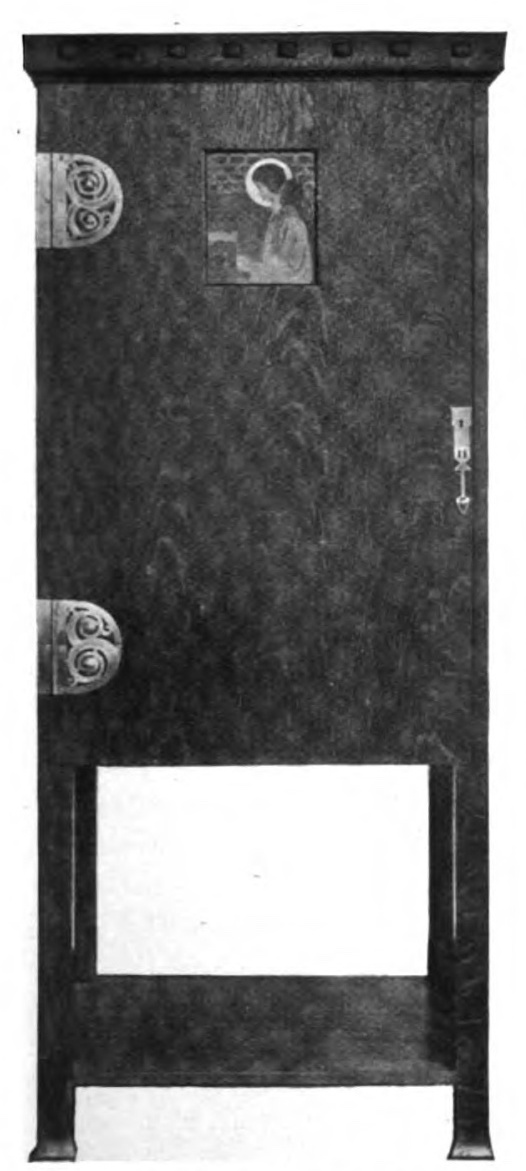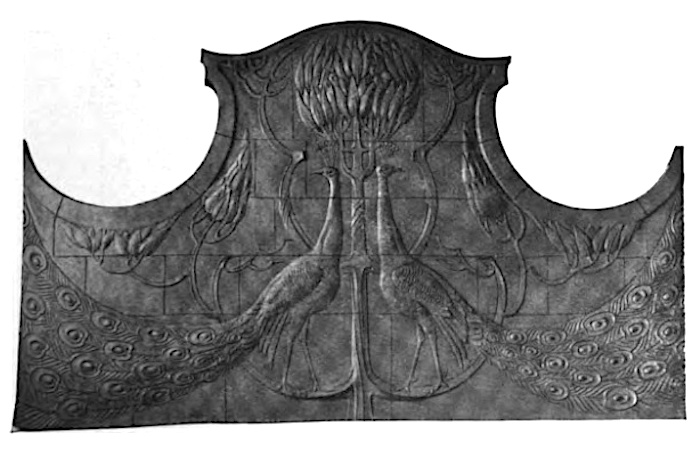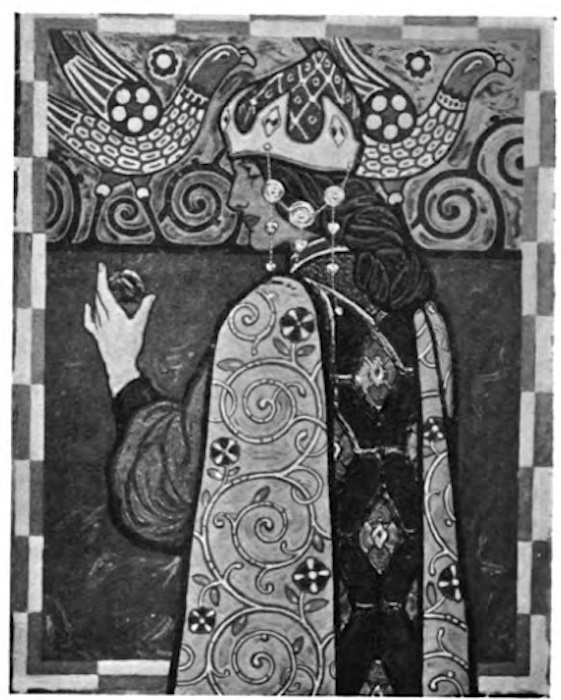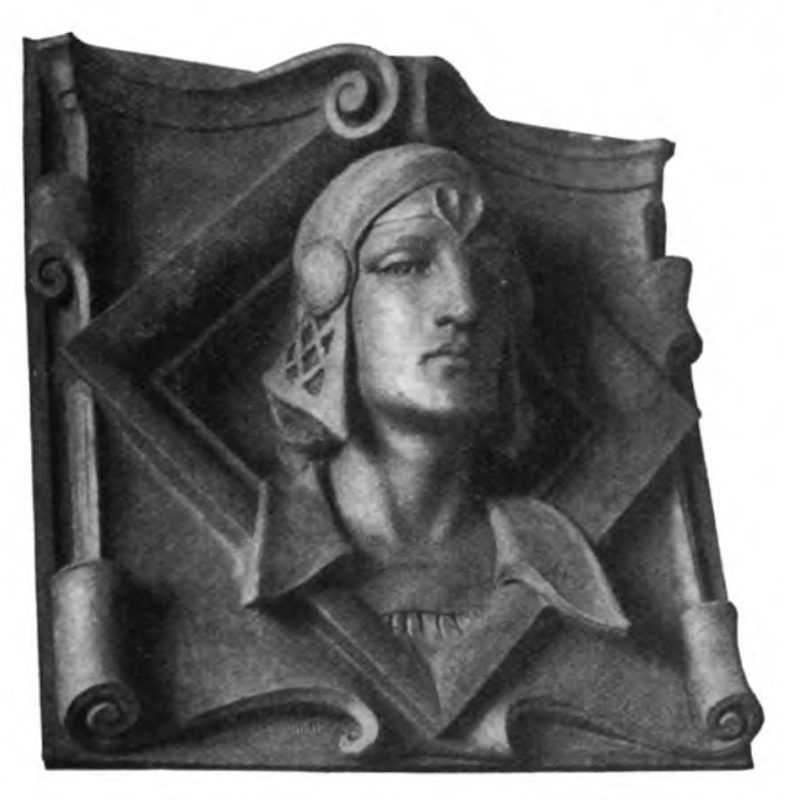This article has been downloaded from a digitalised copy of the International Studio, Vol. 20 (1903), in Harvard University library. It has been proofed and reformatted for this website, and the illustrations have been placed as close as possible to their discussions in the text. Jacqueline Banerjee.

OWEVER individual a man's gift of imagination, however great his manipulative skill may be by nature, early training and associations cannot fail to have left their mark upon him for better or worse, and to have contributed to the formation of his matured work. It is, therefore, not only interesting but profitable, for the better appreciation of an artist, to recall the main points in his career.
No sooner had he left school [in Barnsley, where he was born] than Mr. Neatby, at that time only a boy of fifteen years, was articled to an architect in a northern provincial town. There he remained, as pupil and afterwards as clerk of the works, altogether six years. During that period, if nothing remarkable occurred to break the monotony of ordinary routine work, Mr. Neatby was steadily and diligently acquiring that training and experience which have proved of vast service to him in after life.
From the first the young man's taste inclined him toward the study of monumental art, opportunities whereof he found in the surrounding churches of the East Riding of Yorkshire. Many of them, especially in outlying districts removed from the beaten track, had still, at that date, happily not been subjected to the obliterating hand of the "restorer."
Two years longer, after leaving the office at which he was originally articled, Mr. Neatby followed his architectural profession, at Whitby and other places in Yorkshire; and however little scope for decoration was afforded by many of the tasks in which he had to engage, such as the designing of engine beds and the ironwork for a large mill-roof, the discipline of being brought face to face with problems of matter-of-fact engineering, sheer and simple, forced him to attain a habitual sense of anatomical construction on the one hand, and of the capacity and fitness of material on the other, factors which are never absent even from his most elaborately ornamental compositions.

Interior and Furniture of a Studio. Source: Vallance 113.
At the age of twenty-three Mr. Neatby entered upon a new phase. He took service in the Burmantofts Potteries at Leeds, as designer of tiles for interior decoration. However, he was no mere draughtsman on paper, but used to paint tiles himself and execute them in several different methods.
After six years in this employment Mr. Neatby joined the staff of Messrs. Doulton, of Lambeth, where he took charge of the architectural department for the design and production of mural ceramics. This, it should be understood, is a distinct branch, apart from the vessels and other objects which, on account, no doubt, of their portability, are more widely known to the public at large than are stationary works of architectural nature. The eleven years he spent there gave him the advantage of an extended knowledge of practical technique. Untiring in perseverance and bold in enterprise, his habit has always been to go to the root of matters. In order to be able to superintend and direct he must make himself cognisant of every detail of his craft, from the chemistry of earths and pigments to the utmost possibilities of its resources. The facilities of the firm enabled him to experiment largely, and, by combinations or developments of existing methods, to introduce several fresh processes. And herein lies, as has been remarked already, the strength of Mr. Neatby's work, that he is no mere theorist, but at once a designer, vivid in imagination, and a handicraftsman who has thoroughly mastered the ways and means of his material.
When Mr. Neatby eventually left the employ of Messrs. Doulton, which he did in order to work on his own account, so far from severing his connection with the firm, he maintained with them, and still maintains, the friendliest relations, frequently working in concert together with them when they require a special design supplied, or when he himself has occasion for getting tiles made and fired. Independence, however, of official connection with Messrs. Doulton placed Mr. Neatby in a position to undertake art-work in many other branches which interest him, in addition to ceramics.
Thus he has designed and executed a large amount of stained glass for domestic as well as for ecclesiastical purposes. His strong predilection for this beautiful art was, no doubt, fostered in the first instance by his youthful excursions among the churches of Yorkshire; not a few of those in the district round about where he lived, e.g., Woolley, Elland, and Thornhill, for example, not to mention York Minster itself, and the parish churches of the city, being exceptionally rich in remains of mediaeval glass.

Trivet in pierced and hammered copper and brass. Source: Vallance 117.
Again, Mr. Neatby has a particular gift for metal-work, not only as accessory to furniture, in the way of hinges, lock-plates, scutcheons, etc., for which purposes his designs are as individual in quality as they are decorative, but also in objects complete in themselves, like the trivet illustrated [left]. True, this may not be an article of very particular importance, but, with its gracefully pierced top and its hammered legs, treated in a manner eminently characteristic of the material, it is worthy of note, because it shows how con sistently and carefully, in small things as in great, the artist thinks out every minute detail of his work. He is a skilful enameller on metal, while the personal jewellery, the caskets, cups, lamps, and other articles of metal-work incidentally introduced into his decorative figure compositions manifest his wealth of fancy in all these branches of design.

Music cabinet in green wax-polished oak with metal hinges, and painted panel of St Cecilia. Source: Vallance 117.
In respect of furniture, it was the examination of such examples of Jacobean wood-work as he noticed in old Yorkshire churches that drew Mr. Neatby's early attention to the importance of a sound and simple basis of construction. Yet, the application of this cardinal principle, as he conceives it, in no way involves the revival of Jacobean fashions. Nay, so plain and severe are most of the lines of the furniture designed by him, that it cannot be said to assimilate to any given period. Rather it embodies the simplified essence of all true constructiveness, and depends more on this quality and on its dignified proportions than on any supposititious attraction derived from outward embellishment. But that Mr. Neatby does not disapprove of ornament applied to furniture is proved by the occasional introduction of inlay, painted panel-work or painted carving, the sparsity of which, however, only serves to give them greater emphasis whenever they do occur.

Caryatids in "Carrarra Ware." Source: Vallance 116.
Though he does not undertake to execute actual cabinet-making with his own hand, Mr. Neatby is a capable wood-carver and graver. Allied to these arts is modelling for architectural statuary, in which he is an adept, as his terminal shaped Caryatides, illustrated on this page, fully testify. These figures are of heroic scale, executed in "Carrara ware," that is to say, terra-cotta with an eggshell surface enamel. The two ornaments in unglazed terra-cotta, for the over-door decoration of Orchard House, Westminster [see the two panels below], are typical examples of the artist's design in modelled relief. It should be remarked, however, that Mr. Neatby was not responsible for the eccentric outline of the pediment; and, with regard to the lettering of the name, that it is but a poor specimen, and not one by which the artist should be judged. In the majority of instances where he introduces lettering it is of an excellent standard, being both ornamental of form as well as being bold and clearly legible.



Left to right: (a) Portion of an entrance to a building. Source: Vallance 114.(b) Portion of a frieze in Intaglio Parian enamel. Source: Vallance 115. (c) Panel in unglazed terracotta. Source: Vallance 115.
Akin to modelling is gesso, which Mr. Neatby uses with good effect, either by itself or in combination with decorative painting and for accentuating embroideries or embossed ornaments. A recent work of this description is entitled Dolci Bella, a female head and bust in profile; the lace of the cap and of the throat ornament, the jewels and the sleeve embroidery being rendered with that lavish inventiveness and scrupulous fidelity which are among the artist's most prominent characteristics. The painted panel for the centre of a chimney-piece [see above] is executed in a process of the artist's own invention, which he describes as "tempera impasto." It is not only decorative in effect but admits of the introduction of raised gold and other enrichments, while it is at the same time perfectly hard and durable.

Chimney-piece panel in "Tempera Impasto" and raised gold. Source Vallance 114.
Among some larger works which Mr. Neatby has designed or executed in conjunction with architects, may be mentioned the interior decoration of the Masonic Hall at the Restaurant Frascati, in Oxford Street. The glass of the windows is by the artist, but far more important is his painted decoration of the ceiling and three large mural frescoes, representing throned female figures, attended respectively by leopards, peacocks, and serpents. The whole composition is carried out with a liberal, not too obvious, rendering of Masonic symbolism, and such sustained decorative unity in every part that makes one regret that the work is not in a position where it might have the opportunity of being better known to the general public.
The last remark cannot be said to apply to another, equally clever, achievement of Mr. Neatby's — viz. the ceramic decoration of the large hall for the sale of meat, poultry, game and fish at Messrs. Harrod's Stores in the Brompton Road; yet it would be interesting if one could be assured that any considerable percentage of the customers who frequent the place have ever observed the work in question. It was just a year ago that Messrs. Doulton, having been commissioned to supply the tiles for this purpose, entrusted Mr. Neatby with the designing of the same. The time allowed was only nine weeks, and within that short space the artist had to design and arrange for the entire lining of the large hall with ceramics from roof to floor. The scheme included the making of full-sized cartoons for twenty circular panels, four feet in diameter, all different, depicting scenes of falconry, hunting, game, and other animals, with a conventional tree repeated between each medal lion; four varieties of vesicas with peacocks, pheasants, and other birds for the walls ; and the designing and modelling of the architectural relief ornament of polygonal columns for the doorways, surmounted by golden peacocks. The whole undertaking, conducted at high pressure, was managed with an ingenuity and a fertility of invention truly amazing.


Left: Panel in dark brown terracotta (Messrs Newton and Cheatle, architects). Source: Vallance 116. Right: Chimney-piece panel in enamels and gold. Source: Vallance 114.
Mr. Neatby was responsible, under the architects, Messrs. Newton and Cheatle, for the interior decoration of the King's Cafe at Birmingham; comprising the stained glass, the metal work, and mural tiles, the latter being manufactured for him by Messrs. Doulton. The full-face figure of a king [shown on the right] represents the panel over the fireplace in the same café. It is carried out in Parian enamels and gold, in slight relief, in a very rich scheme of colour.
Another notable work of the artist's is the tile decoration of the arcade that leads into the market square at Norwich.
Lastly, Mr. Neatby is at present engaged on the modelled plaster decoration of the pendentives of the dome of the new Gaiety Theatre; but this work is still so incomplete that anything beyond mere mention of it would be premature, and a detailed account must therefore be left over for some future occasion.
Created 24 January 2020
Last updated (links added) 10 April 2024